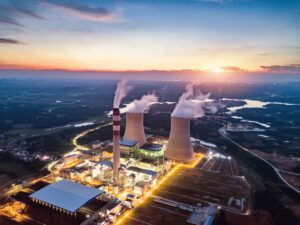Nuclear power is making a global comeback as governments plan for long term energy security amid inflated fossil fuel prices, as well as growing power consumption demand pressures and a backdrop of net-zero transition targets.
Since early 2022, at least 14 countries have approved nuclear units or announced supportive policies, and Asia is leading the charge.
Of all the nuclear projects currently under construction globally, 64% are in Asia. Within the region, reactors in China, India, Korea and Japan represent the majority of new builds and there is ample room to grow. In 2019, nuclear represented just 4% of the power mix in Asia, far below Europe where nuclear generates almost a quarter of the region’s power, or the US where nuclear is at close to 20%.
Nuclear plays a role in decarbonisation as a source of clean power, with the IEA notably forecasting a four-fold increase in annual deployment by 2030 under its Net Zero Scenario. Wind and solar lead the charge in the energy mix of tomorrow, but renewables need to be complemented by dispatchable power. Nuclear power, characterised by high generation stability, is one such candidate to substitute coal as base load power supply.
In China, the world’s largest and fastest-growing producer of renewable energy, regulators approved 16 new nuclear reactor units over the past year. This translates to an aggregated capacity addition of ~16.5GW, or ~Rmb231bn of investment according to J.P. Morgan estimates. Going forward, the push towards carbon neutrality means guidance is for an additional 6-8 units of new approvals a year through 2030. By 2060, China is aiming to be carbon neutral, with nuclear making up ~25% of the country’s power mix, up from about 5% today.
India has also highlighted the key role nuclear power will play in reaching its goal of net zero by 2070. Plans are to triple nuclear power generation capacity to 22.48GW by 2031 from the less than 2% it represents in the energy mix currently. This suggests an expected investment of $17bn and highlights India’s status as one of the few developing countries to have indigenised technology for nuclear reactors. The fact that India has one of the world’s largest Thorium reserves, which can be converted to Uranium in the last of a three-stage nuclear program in India, provides an additional energy security bonus, helping to reduce the country’s heavy reliance on fossil fuel imports.
However, nuclear is one source of zero-emission energy that has sustainability-minded investors divided. Concerns around safety and the environmental implications of radioactive waste products have proved a barrier to nuclear roll-out. Debates around these issues were certainly re-ignited in the wake of the accident at Fukushima Daiichi Nuclear Power Station in 2011. In this sense, social acceptance of nuclear energy is a key consideration for its deployment.
Recently though, it appears the clean-energy profile of nuclear has come to the fore with both Japan and Korea reversing decade-long strategies to phase out the technology. In Korea, the 10th Basic Plan released in January this year, seeks a balanced mix of power generation that will include nuclear as well as renewables. Construction on existing nuclear projects has resumed and the government is considering the build-out of new plants, adding to a list of six that were previously approved.
In Japan, the cabinet approved the ‘Basic Policy for realisation of GX’ in February, stating nuclear energy shall “play an important role as carbon free baseload power to achieve supply stability and carbon neutrality”. Later in May, the GX decarbonised power supply law, which includes an extension of the nuclear power plant operating period to over 60 years, was passed. The law clearly defines the government’s responsibility to use nuclear power plants to ensure a stable supply of electricity and a carbon-free society.
That said, social acceptance of nuclear remains one of the key barriers to widespread deployment, particularly in ASEAN. The debates and social backlash around wastewater release from Fukushima earlier this year highlight how influential public opinion can be in driving the debate around nuclear, and it is not a factor to be ignored. However, with the addition of nuclear to the European taxonomy of green activities last year, and its inclusion on similar green activity lists for Korea and China, nuclear does appear to have moved into ‘ESG’ territory.
